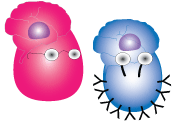
Reflection on T cell subsets
In the last few pages you have seen how Th1, Th2 and Th0 differentiation was influenced by IL-12. We also saw how TGF-β and IL-10 influenced the development of the T regulatory subsets. However, these T cell subsets are far from the only subsets that can arise in our body. But why do we need so many different T cell subsets? Well, the IFN-γ secreting CD4+ Th1 subset interacts with CD8+ cytotoxic T cells to make them better killing machines; hence they are involved in cell-mediated defences. All Th subsets and their cytokines, not only influence each other, but also which antibodies B cells produce (this topic will be covered in the next section), and hence are involved in humoral defences. Perhaps you can now see why we took you all the way back to the pathogen entering the body and the alarm bells going off on the first T cell differentiation page yet again? Think about it! In previous modules we have seen how the innate immune cells responded differently to different types of pathogens, like parasitic worms or virus, and how this affected the antigen presenting cells to produce different kinds of cytokines. We now have told you that these cytokines also affects how the T cells differentiate and make the most appropriate immune response, be it humoral for the parasite, cell-mediated for the virus, or no immune response and tolerance for the harmless food antigens! The storyline is a custom need-driven immune response. Ingenious!